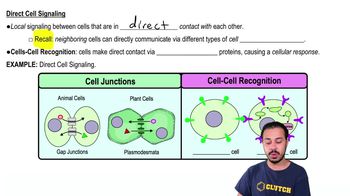Types of Cell Signaling quiz Flashcards
 Back
BackTypes of Cell Signaling quiz
1/15
Terms in this set (15)
- What type of cell signaling involves direct contact between neighboring cells?Direct cell signaling involves local signaling between cells that are in direct contact with each other.
- What structures do animal cells use for direct cell signaling?Animal cells use gap junctions to connect their cytoplasm for direct cell signaling.
- What is the plant cell equivalent of gap junctions?Plasmodesmata are the plant cell equivalent of gap junctions, connecting the cytoplasm of plant cells.
- How do cells recognize each other in cell-to-cell recognition?Cells recognize each other via membrane proteins that cause a cellular response.
- What is the main difference between paracrine and endocrine hormones in indirect cell signaling?Paracrine hormones travel short distances to nearby cells, while endocrine hormones are released into the bloodstream and travel long distances.
- What type of signaling molecule is released by neurons in synaptic cell signaling?Neurotransmitters are the signaling molecules released by neurons in synaptic cell signaling.
- What is the small junction between the end of a neuron and another cell called?The small junction is called a synapse.
- What process allows a signal to be maximized inside a cell after binding to its receptor?Signal amplification allows a signal to be maximized inside a cell.
- Which enzymes are involved in signal amplification by adding or removing phosphate groups?Protein kinases add phosphate groups, and protein phosphatases remove phosphate groups.
- What is the source of the phosphate group added by protein kinases during phosphorylation?The phosphate group typically originates from ATP, which is hydrolyzed into ADP.
- What is the effect of phosphorylation on a protein's activity?Phosphorylation alters a protein's activity, either activating or deactivating it.
- What type of cell signaling is synaptic cell signaling considered to be?Synaptic cell signaling is considered a specific type of paracrine signaling.
- What is the role of neurotransmitters in synaptic cell signaling?Neurotransmitters transmit the signal across the synapse to the target cell, triggering a cell response.
- What happens to the cellular response when signal amplification occurs?Signal amplification leads to a larger cellular response by activating many molecules.
- What happens to a phosphorylated protein when a phosphatase enzyme acts on it?The phosphatase enzyme removes the phosphate group, regenerating the dephosphorylated protein.



